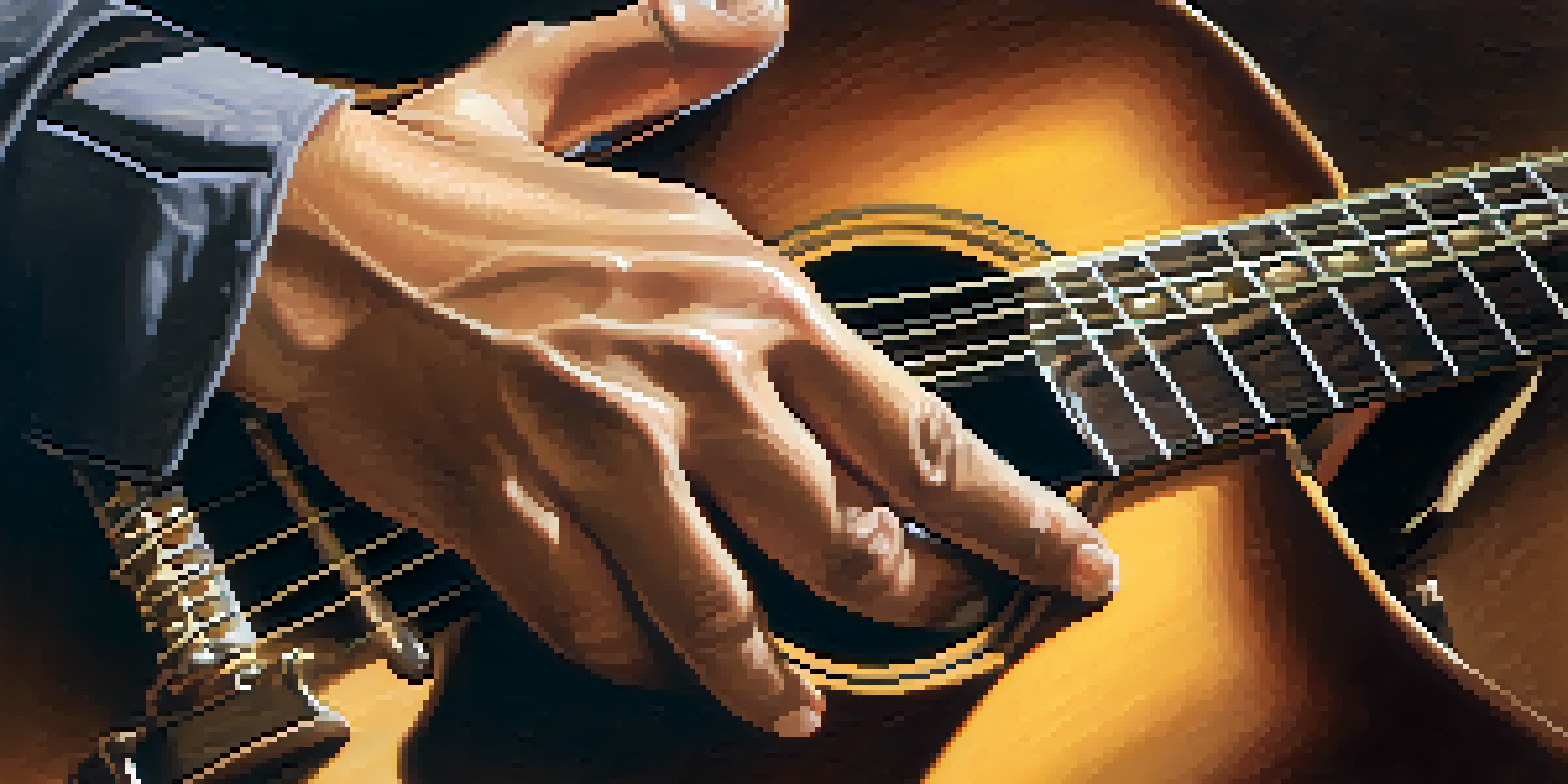Using Scales to Create Unique Melodies on Guitar

Understanding Guitar Scales and Their Importance
Guitar scales are foundational tools that every guitarist should grasp. They serve as the building blocks for melodies, solos, and improvisations. By mastering scales, you unlock a world of musical possibilities, allowing you to express yourself creatively on the guitar.
Music is an outburst of the soul.
Think of scales as the alphabet of music; just as letters combine to form words, scales combine to create melodies. When you understand how to navigate these scales, you can craft unique musical phrases that resonate with your emotions and experiences. It’s all about knowing how to make those notes sing.
Additionally, scales help you develop your ear for music. As you practice, you'll start to recognize patterns and intervals, which are crucial for composing memorable melodies. This understanding will not only enhance your playing but also deepen your appreciation of music.
Exploring Major and Minor Scales
Major and minor scales are the most common scales used in music, each evoking different emotions. Major scales often sound bright and happy, while minor scales tend to convey a more somber or reflective mood. Understanding these two types of scales can significantly influence the melodies you create.

For example, if you're aiming for an uplifting melody, you might lean on a major scale, experimenting with its notes to find that perfect catchy phrase. On the other hand, if you want to express melancholy or introspection, a minor scale can be your best friend. This emotional connection is key to writing impactful music.
Guitar Scales as Musical Foundations
Mastering guitar scales unlocks creative possibilities for melodies and improvisation.
To get started, try playing a simple melody using both a major and a minor scale. Notice how the mood shifts with each scale. This exercise will give you a clearer sense of how different scales can shape your musical ideas.
Utilizing Pentatonic Scales for Melodic Creativity
Pentatonic scales, consisting of only five notes, are incredibly versatile and popular across many genres. These scales simplify the process of melody creation while allowing for a broad range of expression. They are particularly effective in rock, blues, and country music.
The beautiful thing about learning is that no one can take it away from you.
One of the beauties of the pentatonic scale is that it’s hard to hit a wrong note. This makes it a favorite among beginners and seasoned musicians alike. When you play around with these five notes, you'll find countless combinations that can lead to unique and captivating melodies.
Try improvising a solo using a pentatonic scale over a simple chord progression. You’ll be amazed at how quickly ideas flow, and you might just stumble upon a melody that you love!
Experimenting with Modes to Enhance Melodies
Modes are variations of scales that start on different degrees of the scale, offering unique flavors to your melodies. Each mode has its own distinct sound and mood, allowing you to break away from the conventional major and minor scales. Understanding modes can significantly expand your melodic palette.
For instance, the Dorian mode has a jazzy, sophisticated vibe, while the Mixolydian mode feels more bluesy and laid-back. By experimenting with different modes, you can add depth and intrigue to your compositions. This is especially useful when you want to create something that stands out.
Emotional Impact of Major and Minor
Understanding major and minor scales helps shape the emotional tone of your music.
To get started with modes, try playing a melody in a major scale, then switch to its corresponding mode. Notice how the feel of your melody shifts, and explore which modes resonate with your style.
Incorporating Arpeggios for Unique Melodic Lines
Arpeggios are another fantastic way to create unique melodies on guitar. An arpeggio is simply the notes of a chord played in sequence rather than simultaneously. This technique can add a beautiful texture to your music, giving it a more intricate feel.
By incorporating arpeggios into your playing, you can create melodies that intertwine with the harmonic structure of your song. For example, if you have a C major chord, try playing the notes of that chord as an arpeggio while adding embellishments. This approach can turn a basic melody into something captivating.
To practice, select a chord and play its arpeggio up and down. Then, try to create a melody using those notes, allowing your creativity to flow freely. You’ll discover a new layer of expression in your guitar playing.
Creating Melodic Variations for Enhanced Interest
Once you have a melody, consider making variations to keep things fresh and engaging. Variations can involve changing the rhythm, altering notes, or even shifting the scale you use. This technique can turn a simple tune into a captivating journey.
For example, if you have a catchy melody, try altering its rhythm slightly or adding slides and bends. This not only keeps the melody interesting but also showcases your creativity as a guitarist. Think of it as telling a story where each variation adds a new twist.
Mindful Practice Enhances Creativity
Engaging in mindful practice allows for deeper musical exploration and unique melody creation.
Experimenting with variations can lead to unexpected discoveries in your music. Record yourself playing a melody, then play it back and try to create variations. You might just find a new favorite way to express your musical ideas.
Practicing Mindfully to Unlock Your Melodic Potential
Mindful practice is essential for developing your ability to create unique melodies. Instead of mindlessly running through scales, focus on the sounds you produce and how they resonate with you. This intentional approach can lead to deeper musical insights and more satisfying melodies.
Try setting aside time where you explore scales without any specific goal, just allowing yourself to play freely. This can be a great way to discover new patterns or even stumble upon a melody that speaks to you. Remember, the journey of musical exploration is just as important as the destination.

Additionally, consider recording your practice sessions. Listening back can provide valuable feedback and help you identify which melodic ideas resonate with you. This process of reflection will sharpen your skills and deepen your connection to the music you create.